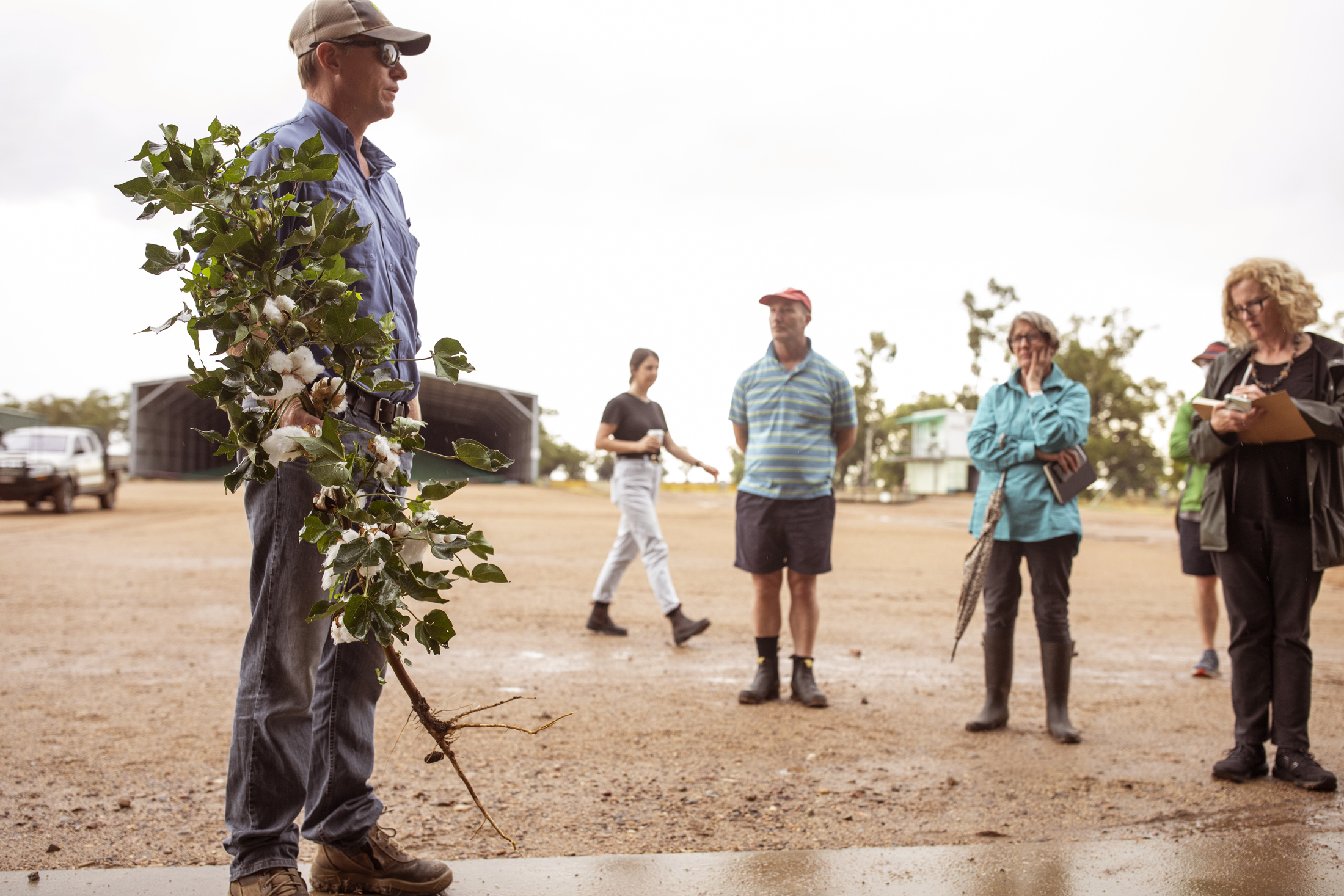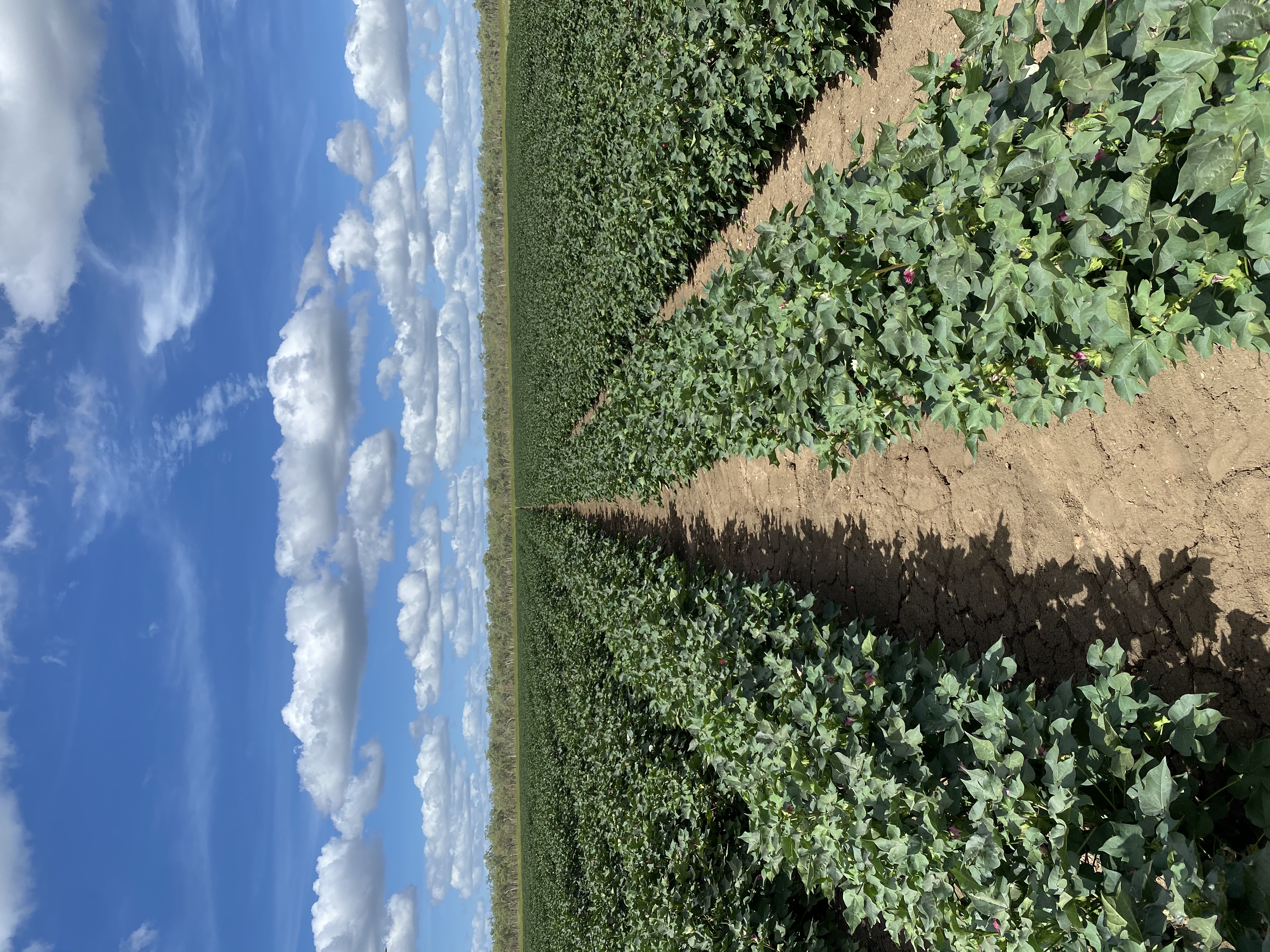Carbon positive, water efficient and growing within an ethical and traceable supply chain are the signatures of Good Earth Cotton pioneered by innovative growers David and Danielle Statham who run Sundown Pastoral Company in New South Wales and Queensland.
Their Keytah farm at Moree, NSW, hosted the Painted River Project and Bank Art Museum Moree in March 2022 to facilitate conversations and creativity around the use of water and natural resources in the sustainable production of food and fibre as the essence of life.
There are 1600 cotton farms operating across Australia in what is a successful, high-pressure industry on farms that are amongst the biggest in the world. Collectively these farmers apply technology including high-yielding seed that has been genetically modified using a naturally-occurring protein to maximize production while using integrated pest management to reduce chemical usage by 97 percent (ie once they sprayed up to 16 times to control insects, now only 1 or 2). Technology also has driven water-use efficiency measures that grow more cotton with less water. David Statham said these changes have occurred alongside increasing community awareness of the need to conserve natural resources and protect ecosystems. Seventy percent of water flows are allocated to environmental flows to protect natural habitats, river systems and wetlands which feed the Murray Darling River System.

Keytah farm manager talking cotton with Painted River Project artists – Moree 2022 Photo by Sally Tsoutas
The Stathams’ are industry leaders pioneering dryland cotton production in far north Queensland as well as bringing their ecological and modern regenerative on-farm innovations further up the complex supply chain to become what they say is the world’s first carbon-positive, sustainable, traceable, ethical cotton company.
David’s family background in agribusiness means their operations are driven by technology and metrics and this, combined with Danielle’s background in textiles and fashion, has led to the creation of a team pursuing best-practice excellence to underpin the Good Earth Cotton brand.
David told educators, artists, and community members gathered for the Painted River Project that Keytah farm practices modern regenerative agriculture using science and metrics to define and prove it. For decades they have gathered on-farm data that enables the business to demonstrate continual improvement in water-use efficiency and yields that now grow more than two bales of cotton per megalitre of water compared to one bale previously (227kg per bale).

Modern regenerative agriculture at Keytah farm underpins Good Earth Cotton brand. Photo supplied
David said this data has been independently verified to show their modern regenerative practices, which include minimising soil disturbance, have created a farm enterprise that is demonstrably carbon positive. The soil acts as a giant carbon sink, with young growing plants drawing down more carbon dioxide from the atmosphere than they need to grow and locking it in soil in a process known as carbon sequestration. The carbon-positive credential is derived from their 2017-2018 soil carbon score showing -420 kg of CO2e per 227kg bale of cotton was sequestered. This equates to the denim used in each pair of jeans sequestering 2kg of carbon while it grows. The soil data also shows constant biological improvement, demonstrating their regenerative processes are protecting and restoring biodiversity of plants, animals and microbiome in measurable ways.
Danielle said Good Earth Cotton represents ethical production because it respects and values their people and the natural resources borrowed from the earth to grow the fibres, and has partnered with like-minded companies to evolve a traceable supply chain rather than a blended commodity pipeline of unclear origin.
With the goal of being able to trace her own denim, Danielle pioneered FibreTrace to verify Good Earth Cotton, and now believes it is the only technology in the world to collate information and hold data to show the absolute truth, in real time, through a patented physical and digital tracing system. The cotton’s physical origins are embedded in organic rare-earth pigments which can be scanned through the yarn and garment stages, and tracked using a purpose-built blockchain system.
The Stathams believe that by demonstrating their sustainability actions and telling the story of Good Earth Cotton, they can help allay consumer concerns about the environmental credentials of their fibre and enable cotton to reclaim market share from its main competitor – which is garments made from polyester.
Polyester is a synthetic/plastic fibre derived directly from fossil fuels and research shows it is shedding microplastic particles into the ecosystem that never breaks down. Recycled polyester also sheds microplastic particles. Consumers are rightly confused by the lack of transparency that has enabled polyester to receive a higher sustainability rating than cotton. This is why we need to know more about what our clothes are made from.